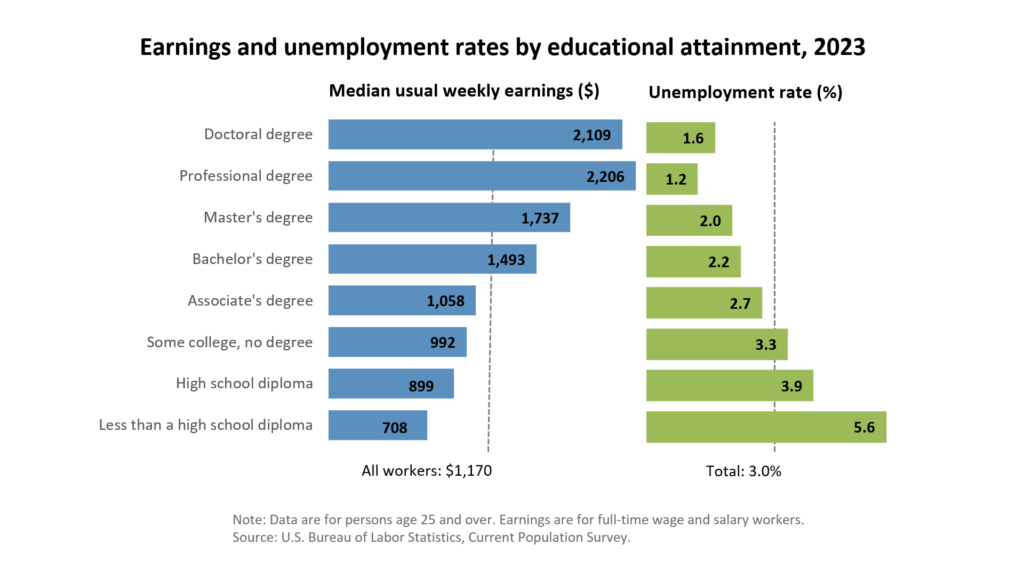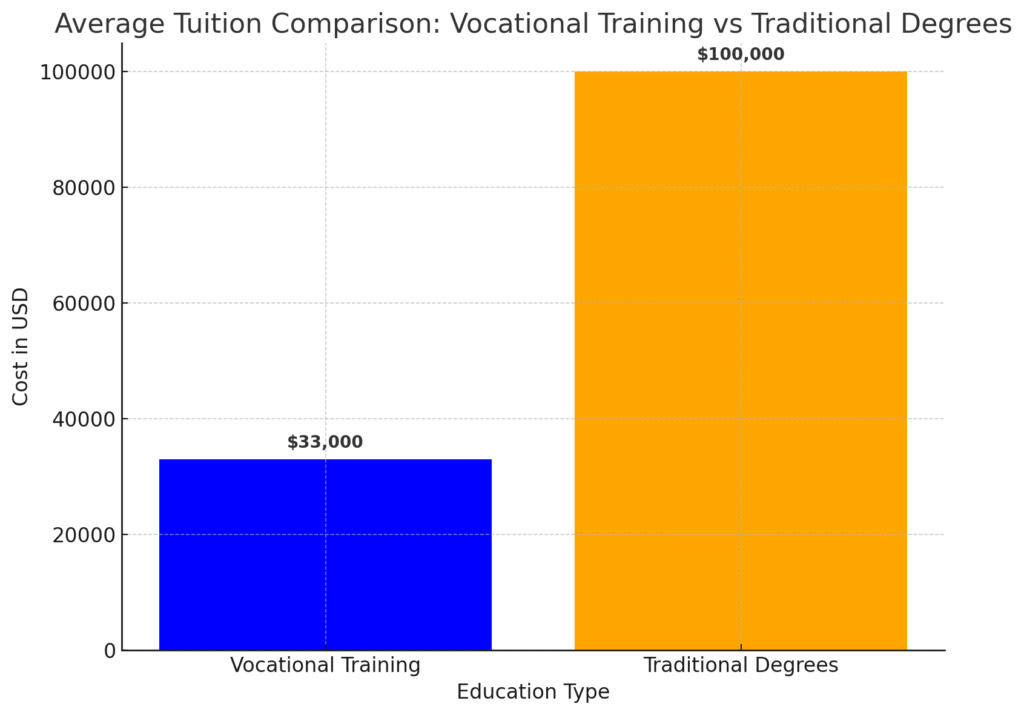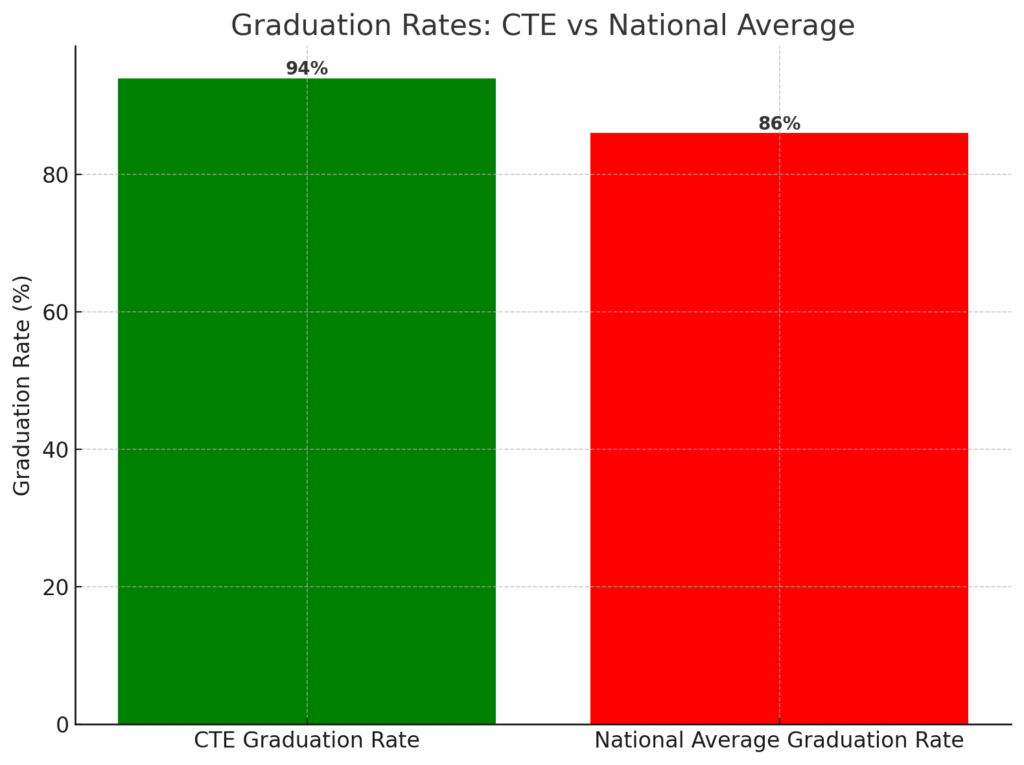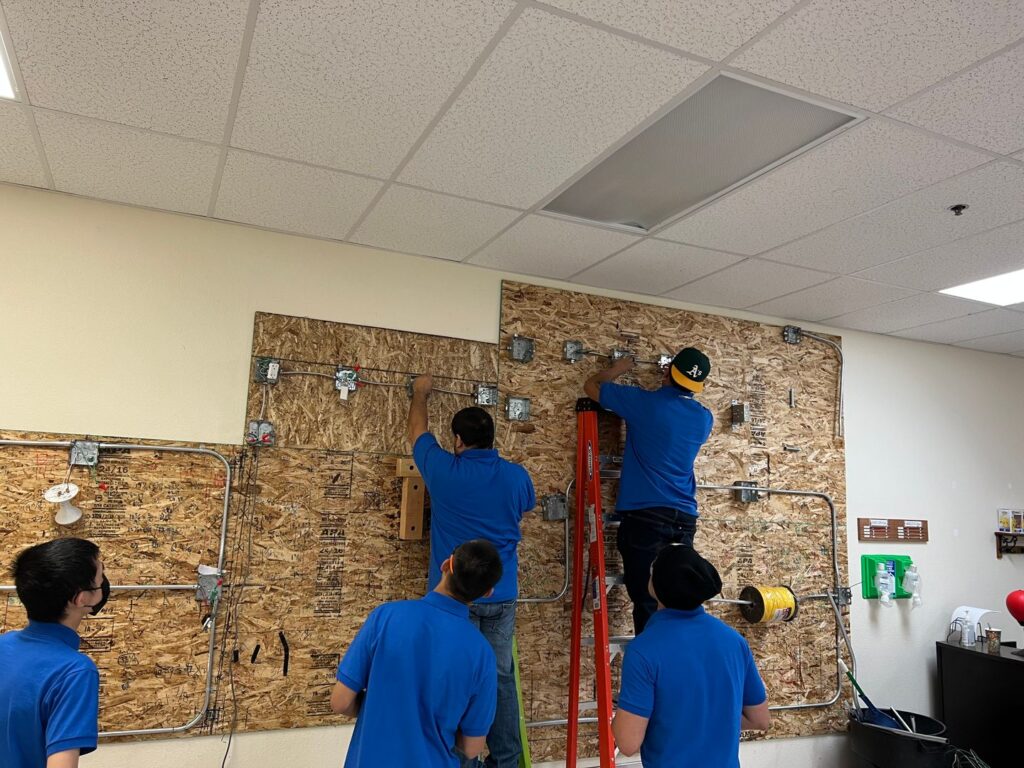In our rapidly evolving job market, vocational schools are emerging as beacons of opportunity, guiding students toward fulfilling and in-demand careers. These institutions, including InterCoast Colleges, are not just educational establishments but gateways to real-world success. They cater to diverse career aspirations, from healthcare and technology to skilled trades, offering specialized programs that align closely with industry needs.
By focusing on practical skills and hands-on experience, vocational education schools are uniquely positioned to bridge the gap between traditional academic pathways and the dynamic demands of today’s workforce. This approach fosters a direct link to employment opportunities and empowers students to swiftly adapt to occupational landscapes, ensuring their skills remain relevant and sought-after. Occupations requiring vocational training are projected to grow by 10% between 2023 and 2033, compared to an average growth rate of 4% for all occupations (U.S. Bureau of Labor Statistics, 2023) [citation:4, Employment Projections Home Page: U.S. Bureau of Labor Statistics](https://www.bls.gov/emp/).

Exploring the Essence of Vocational and Trade Schools
Vocational and trade schools are pivotal in equipping individuals with the technical skills and practical knowledge essential for specific careers. Unlike conventional education routes, these schools concentrate on delivering targeted training programs that prepare students for immediate entry into their chosen fields. Through a blend of classroom learning and real-world applications, students receive an education that is directly aligned with the needs of employers, making them highly competitive candidates upon graduation. The average tuition for vocational training, around $33,000, makes it a cost-effective alternative compared to traditional degrees, which often exceed $100,000 (OECD, 2023) [citation:3, Spotlight on Vocational Education and Training: Findings from Education at a Glance 2023 | OECD iLibrary](https://www.oecd-ilibrary.org/education/spotlight-on-vocational-education-and-training_acff263d-en).

Understanding the Vocational School Paradigm
The vocational school paradigm shifts the focus from broad-based academic studies to specialized, career-oriented training. This educational model emphasizes the acquisition of specific skill sets and practical expertise over theoretical knowledge, preparing students for direct entry into the workforce. It caters to various interests and industries, from healthcare and cybersecurity to the electrical and HVAC industry, reflecting the diverse needs of today’s economy and labor market.
The Role of Career and Technical Education (CTE) in Today’s Economy
CTE programs play an instrumental role in today’s economy by preparing students for high-demand career fields without needing a traditional four-year degree. These programs offer a pragmatic approach to education, focusing on equipping students with the skills necessary to thrive in specific careers. By aligning closely with the needs of industries, CTE ensures that graduates are ready to enter the workforce and positioned to excel in their chosen career fields, making them invaluable assets to employers. CTE students have higher graduation rates, with over 94% completing high school, compared to the national average of 86% (National Center for Education Statistics, 2020) [oai_citation:2, Career and Technical Education (CTE) Statistics-CTE Statistics](https://nces.ed.gov/surveys/ctes/).

How Vocational and Trade Schools Equip Students for the Future
Vocational and trade schools lay a strong foundation for student’s future success by offering training programs designed to meet the current and emerging needs of the labor market. From skilled trades to graphic design, these programs provide a mix of theoretical knowledge and practical skills, emphasizing hands-on learning. This approach ensures that students in vocational education are well-prepared to seize career opportunities, bridging the skills gap and addressing the demand for skilled workers. The healthcare sector, in particular, is expected to grow by 15% by 2033, mainly due to the rising demand for healthcare support professionals (U.S. Bureau of Labor Statistics, 2023) [oai_citation:1, Employment Projections Home Page: U.S. Bureau of Labor Statistics](https://www.bls.gov/emp/).
The Evolution of Vocational Education in the 21st Century
The landscape of vocational education has undergone significant transformations in the 21st century, driven by the changing demands of the economy and technological advancements. These changes have reshaped career fields and necessitated a shift in training methods, making vocational education a more attractive and viable option for many. By adapting to these changes, vocational schools ensure that their students are well-equipped to meet the needs of modern employers and succeed in their chosen career fields.
The Impact of Technological Advancements on Vocational Training
Technological advancements have profoundly impacted vocational training, introducing new tools and methodologies that enhance learning outcomes. Vocational programs have evolved to incorporate cutting-edge technology, ensuring students are proficient in the latest industry-standard software and equipment. This enriches the learning experience and ensures graduates are technologically savvy, giving them a competitive edge in the job market.
Shifting Trends: The Drive Towards Hands-On Training
The trend towards more hands-on training in vocational education is a response to the evolving needs of industries and employers. Schools prepare students for the workforce by providing extensive hands-on training that simulates real-world scenarios. This approach reinforces theoretical knowledge and builds confidence and competence, ensuring that graduates are job-ready and capable of performing at a high level from day one.
Why Keeping Up with Educational Trends is Crucial
Staying abreast of educational trends is crucial for vocational training institutions to remain relevant and effective. Vocational schools can provide a high-quality and value education by integrating the latest technical skills, adapting CTE programs to meet current industry demands, and being mindful of school costs and student loans. This adaptability ensures that students receive an education that prepares them for the challenges and opportunities of the modern workforce.
Industries Benefiting from Modern Vocational Training
Modern vocational training programs are instrumental in meeting the workforce needs of various industries. From healthcare and information technology to construction and manufacturing, vocational programs equip students with the skills and knowledge necessary to excel in these fields. This targeted training benefits students by providing them with a clear path to career success and supports industries in filling critical skill gaps, ensuring economic growth and innovation.

Emerging Career Paths Shaped by Vocational Education
Vocational education is at the forefront of developing new career paths that cater to the evolving needs of the economy. By offering specialized training in emerging career fields, vocational schools are preparing students for future success in sectors that are on the rise. This proactive approach to education ensures that students are well-equipped to navigate the challenges of the modern job market and seize opportunities in new and expanding career fields.
The Practicalities of Choosing a Vocational Path
Choosing a vocational path offers a pragmatic approach to education, allowing students to focus on acquiring the skills and knowledge necessary for specific careers. This decision is not only about selecting an area of study but also about considering the practicalities of entering the workforce in a timely and cost-effective manner. Vocational education provides a direct route to employment, making it an appealing option for those eager to embark on their career journey.
Online Versus On-Campus: Finding the Right Fit for Vocational Training
The hybrid option is also worth considering when choosing between online and on-campus vocational training programs. This program primarily takes place online but includes a few days on campus for hands-on training. The hybrid option offers the best of both worlds, providing the flexibility and convenience of online learning while still allowing for valuable in-person experience. As with any learning format, it’s important to consider one’s learning style and career goals when deciding on the best option.
Admission Requirements and How to Prepare
Embarking on a journey towards a new career begins with understanding the specific admission requirements of vocational schools. The admission requirements for InterCoast College typically include being at least a certain age or having a valid High School Diploma or GED equivalent.
The Importance of Accreditation in Vocational Schools
Choosing a vocational school with the right accreditation is crucial, as it assures the quality and credibility of the programs offered. Accreditation from the accrediting bodies recognized by the U.S. Department of Education ensures that the education meets specific standards of excellence and that graduates are prepared for their chosen careers. InterCoast Colleges is institutionally accredited by the Accrediting Council for Continuing Education & Training (ACCET) and approved by the State of California Bureau for Private Postsecondary Education (BPPE). These accreditations demonstrate our commitment to providing quality education and training.
The Advantages of Pursuing Vocational Education
Vocational education offers a streamlined path to career readiness, focusing on practical skills and hands-on training. Moreover, vocational education leads directly to a degree or certificate in specialized fields, enabling graduates to enter the workforce swiftly and with the competencies employers desire.
Preparing Students Directly for the Workforce
In vocational education, many fields provide specialized training to individuals seeking a career in their desired field. For example, Alcohol and Drug Counseling Studies provide students with the necessary skills and knowledge to support individuals struggling with addiction. Similarly, electrical training programs prepare students for careers in the electrical industry by providing them with hands-on experience and knowledge of the latest technologies and safety procedures. Each program focuses on practical, real-world experience, ensuring students are well-prepared for the workforce upon graduation.

The Efficiency of Vocational Training Programs
Vocational training programs, especially in states like California, are tailored to meet the fast-paced demands of today’s job market. These programs are efficient not only in terms of time, often allowing students to complete their studies and enter the workforce quicker than traditional four-year degree paths, but also in how closely they align with the needs of local industries. This alignment ensures that the skills students acquire are directly applicable to their chosen field, making them immediately valuable to employers upon graduation.
Popular Vocational Programs That Lead to Rewarding Careers
Cybersecurity is a constantly evolving industry with a growing demand for trained professionals. Vocational programs offer comprehensive training in network security, information assurance, risk management, and other specialized areas. Graduates from these programs are equipped with the skills to identify and mitigate cyber threats, protect sensitive information, and safeguard against data breaches. With cybersecurity being a critical concern for all organizations today, the career prospects for these professionals are excellent, making it a highly rewarding field to pursue.
Online Programs: Bridging the Gap in Vocational Training
Online programs have become a pivotal component of vocational training, offering a flexible and accessible pathway for students to advance their education and career prospects. With experienced faculty members leading online courses, students receive the same quality education as their on-campus counterparts, ensuring they are equally prepared to meet the demands of the workforce.
A Deeper Dive into Vocational School Success Stories
In our journey to illuminate the transformative impact of vocational education, we’ve gathered a collection of success stories that truly showcase the power of career and technical education (CTE) pathways. Through in-depth interviews with industry leaders and successful graduates, we’ve seen firsthand how vocational schools are not just alternatives but are pivotal in shaping the future workforce. These narratives serve as a beacon, highlighting the vital role of vocational training in unlocking potential and fostering economic growth.
The Impact of ACCET on Guiding Students to Vocational Pathways

The Accrediting Council for Continuing Education & Training (ACCET) is an important organization that ensures the quality and integrity of trade schools. Established in 1974 and endorsed by the U.S. Department of Education since 1978, ACCET evaluates and improves continuing education and training programs worldwide. Focusing on non-traditional educational providers, such as vocational colleges, ACCET provides accreditation, resources, and guidance to maintain educational standards. Its commitment to peer evaluation and support services highlights its significance in promoting excellence within trade schools. This fosters an environment conducive to skill development and professional advancement.
Deciphering Current Trends in Vocational Education
Staying abreast of current trends in vocational education is not just beneficial; it’s essential. The rapid evolution of technical skills and the expansion of CTE programs reflect the industry’s responsiveness to the changing demands of the workforce. This adaptability ensures that vocational training remains relevant, equipping students with the competencies to navigate and succeed in today’s job market. Such trends underscore the importance of vocational education as a cornerstone for building a skilled and versatile workforce.
Debunking Myths: The Value of Vocational vs. University Education
The debate over the value of vocational education versus a traditional university degree has been long-standing. However, it’s becoming increasingly clear that vocational schools offer a distinct yet equally valuable pathway to success. By focusing on practical skills and job readiness, vocational education prepares students for immediate entry into the workforce, often in high-demand fields. This approach meets the urgent needs of industries and provides students with a viable route to financial stability and career fulfillment.
The Unspoken Benefits of CTE Education and Its Role in Modern Workforce Development
CTE programs are crucial in modern workforce development, albeit often underappreciated. By aligning education with the specific needs of industries, CTE programs create a seamless transition from classroom to career, ensuring that students embark on a career path equipped with the necessary skills and knowledge. This symbiotic relationship between education and industry benefits students and strengthens the economy by filling critical skill gaps. The unspoken benefits of CTE education are thus manifold, fostering a skilled, adaptable, and competitive workforce.

Final Thoughts: Vocational Schools as Gateways to Empowerment and Prosperity
In reflecting upon the journey through the landscape of vocational education, we recognize vocational schools in the United States as pivotal in shaping a future where practical skills and professional training intersect with career success. Vocational schools typically offer a pathway that diverges from the traditional academic route of a liberal arts college, focusing instead on equipping students with the practical skills necessary for immediate entry into the workforce. This approach meets the immediate needs of industries hungry for skilled labor and empowers students with a sense of purpose and direction.
The percentage of students completing their programs at technical colleges and career schools highlights the efficacy of vocational education in maintaining high completion rates and academic standards. In an economy where the demand for skilled professionals in fields like cybersecurity is ever-increasing, the role of vocational education in the United States cannot be overstated. By fostering an environment where practical training meets professional aspiration, vocational schools serve as educational institutions and gateways to empowerment and prosperity.
Contact us today to learn more about our programs.
Sources:
1. U.S. Bureau of Labor Statistics, Employment Projections (2023–2033): BLS Employment Projections
2. OECD, Vocational Education and Training Statistics (2023): OECD Vocational Education Report
3. National Center for Education Statistics, CTE Graduation Rates (2020): NCES CTE Statistics

